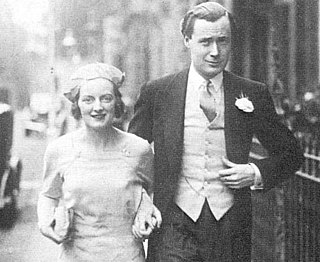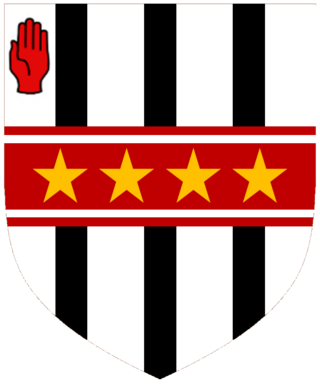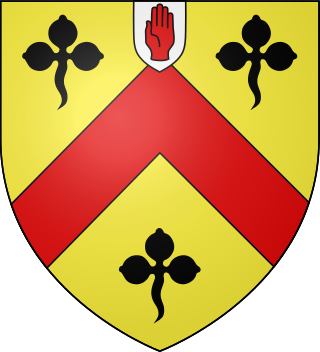This article needs additional citations for verification .(February 2013) |
There have been two baronetcies created for people surnamed "Bailey", both in the Baronetage of the United Kingdom and extant as of 2010.
This article needs additional citations for verification .(February 2013) |
There have been two baronetcies created for people surnamed "Bailey", both in the Baronetage of the United Kingdom and extant as of 2010.
The Bailey baronetcy, of Glanusk Park in the County of Brecon, was created in the Baronetage of the United Kingdom on 5 July 1852. [1]
The Bailey baronetcy, of Cradock in the Province of the Cape of Good Hope in the Union of South Africa, was created in the Baronetage of the United Kingdom on 12 February 1919 for the South African diamond magnate and politician Abe Bailey. [2] His eldest son, the second Baronet, married Diana Churchill, eldest child of Winston Churchill. However, they were divorced in 1935. The second Baronet was succeeded by his half-brother, the third Baronet. He was the son of the first Baronet by his second wife the Honourable Mary Westenra, an aviator. The third Baronet was also an influential businessman. As of 2010 the title is held by his son, the fourth Baronet, who succeeded in 2009.

| Bailey baronets | |
|---|---|
| Crest | A demi-female figure with arms extended Proper habited Azure trimmed at the collar cuffs and shoulders Argent holding in each hand a sprig of mimosa as in the arms. |
| Shield | Argent on a fess between three martlets Gules a bezant between two sprigs of mimosa Proper. |
| Motto | Virtus Castellum Meum [3] |
The heir apparent is the current baronet's eldest son, James Edward Bailey (born 7 September 1983).

Earl Grey is a title in the peerage of the United Kingdom. It was created in 1806 for General Charles Grey, 1st Baron Grey. In 1801, he was given the title Baron Grey of Howick in the County of Northumberland, and in 1806 he was created Viscount Howick in the County of Northumberland, at the same time as he was given the earldom. A member of the prominent Grey family of Northumberland, Earl Grey was the third son of Sir Henry Grey, 1st Baronet of Howick.

Baron Glanusk, of Glanusk Park in the County of Brecknock, is a title in the Peerage of the United Kingdom. It was created in 1899 for Sir Joseph Bailey, 2nd Baronet, who had earlier represented Herefordshire and Hereford in the House of Commons as a Conservative. Both his son, the second Baron, and grandson, the third Baron, served as Lord Lieutenant of Brecknockshire. The latter was succeeded by his first cousin, the fourth Baron. He was the son of the Hon. Herbert Crawshay Bailey, fourth son of the first Baron. As of 2010 the titles are held by his son, the fifth Baron, who succeeded in 1997.

There have been three baronetcies created for persons with the surname Booth, one in the Baronetage of England and two in the Baronetage of the United Kingdom. The 1916 creation remains extant, the 1835 creation became extinct in 1896 and the 1611 baronetcy has been dormant since 1797. The senior line of the first creation was elevated to the peerage as Baron Delamer and Earl of Warrington.

Diana Spencer Churchill was the eldest daughter of British statesman Sir Winston Churchill and Clementine Churchill.
There have been two baronetcies created for members of the Orr-Ewing family, both in the Baronetage of the United Kingdom. Both creations are extant as of 2010.
Two baronetcies with the surname Arbuthnot have been created for members of the Arbuthnot family—both in the Baronetage of the United Kingdom, and still extant.

Sir Abraham Bailey, 1st Baronet, known as Abe Bailey, was a South African diamond and gold tycoon, politician, financier and cricketer.
There have been four baronetcies for persons with the surname Blake, one in the Baronetage of Ireland, two in the Baronetage of Great Britain and one in the Baronetage of the United Kingdom. Two of the creations are extant as of 2010. The Blake Baronetcy, of Menlough in the County of Galway, was created in the Baronetage of Ireland on 10 July 1622 for Valentine Blake, Mayor of Galway in 1611 and 1630 and a member of the Irish House of Commons for County Galway. His grandfather Thomas Blake had preceded him as Mayor. The second Baronet was a member of the Irish Parliament for Galway Borough. The third Baronet represented both County Galway and Galway Borough in Parliament. The sixth Baronet was a member of the Irish House of Commons for County Galway. He was the first Catholic gentlemen of distinction to join William of Orange. The twelfth Baronet represented Galway Borough in the British House of Commons. The fourteenth Baronet was high sheriff of County Galway in 1872. See also the Blake Baronetcy of Twizell Castle below.

The Chaytor family is an English gentry family on which has been conferred two baronetcies, one in the Baronetage of England and one in the Baronetage of the United Kingdom and several knighthoods. As of 2008 one baronetcy is extinct.
There have been six baronetcies created for persons with the surname Brooke, one in the Baronetage of England, one in the Baronetage of Ireland and four in the Baronetage of the United Kingdom. As of 2015 four of the creations are extant, though one has been subsumed into a peerage.

There have been four baronetcies created for persons with the surname Miller, two in the Baronetage of England, one in the Baronetage of Great Britain and one in the Baronetage of the United Kingdom. Two of the creations are extant as of 2008.
There have been seven baronetcies created for persons with the surname Edwards, three in the Baronetage of England and four in the Baronetage of the United Kingdom. Only one creation is extant as of 2007.
Three baronetcies were created for persons with the surname D'Oyly, two in the Baronetage of England and one in the Baronetage of the United Kingdom. One creation is extant as of 2008.

The Jaffray Baronetcy, of Skilts in the Parish of Studley in the County of Warwick, is a title in the Baronetage of the United Kingdom. It was created on 8 October 1892 for the journalist and newspaper proprietor John Jaffray. He was the co-founder of the Birmingham Post and Birmingham Mail.
The Brown, later Pigott-Brown Baronetcy, of Broome Hall in Capel in the County of Surrey, is a title in the Baronetage of the United Kingdom. It was created on 5 January 1903 for Alexander Hargreaves Brown, Liberal Member of Parliament for Wenlock from 1868 to 1885 and Liberal Unionist Member of Parliament for Wellington from 1885 to 1906. He was the third son of Alexander Brown, eldest son of Sir William Brown, 1st Baronet. Brown's eldest son Captain Gordon Hargreaves Brown was killed in action in the First World War. In 1910 he had married Edith Ivy, eldest daughter and co-heir of Admiral William Harvey Pigott. She assumed in 1925 the additional surname of Pigott for herself and her issue. Their son, the second Baronet, was killed in action in the Second World War. On the death without issue in 2020 of the latter's only son, the third Baronet, who succeeded in 1942, the baronetcy became extinct.

Sir Andrew Agnew, 8th Baronet DL was a Scottish politician and baronet.
Commander Sir Henry Stapleton Mainwaring, 5th Baronet JP was an English soldier and actor.
Sir Alexander Bannerman, 6th Baronet was a Scottish doctor and professor of medicine at the University of Aberdeen.

The Abdy Baronetcy, of Albyns, in the County of Essex, was created in the Baronetage of the United Kingdom on 22 December 1849 for Thomas Neville Abdy who sat for Lyme Regis in the British House of Commons. It was a second creation for the seat: see Abdy baronets of Albyns (1660).
Sir Francis Salwey Winnington, 5th Baronet DL JP was an English baronet.